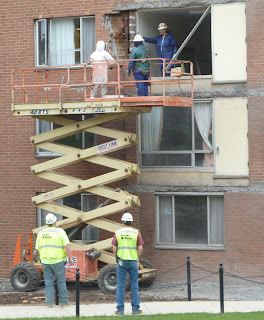 When a construction crew is willing to bring in some workers on Saturday to save a honeybee colony, Roy figured that we beekeepers should do our part as well. He led the charge, scouted the site and was there first thing Saturday morning to help the crew start removing bricks and mortar in an effort to extract a colony that was living in a building on the Penn State campus. That's him in the bee suit on the scissor jack in the photo at the right.
When a construction crew is willing to bring in some workers on Saturday to save a honeybee colony, Roy figured that we beekeepers should do our part as well. He led the charge, scouted the site and was there first thing Saturday morning to help the crew start removing bricks and mortar in an effort to extract a colony that was living in a building on the Penn State campus. That's him in the bee suit on the scissor jack in the photo at the right.The rest of us — Jim, Steve, Matt and Joe — showed up shortly thereafter to lend a hand. We brought all of our beekeeping stuff, but the key pieces were cardboard nucs, empty frames, rubber bands and, of course, hive tools. The plan was to cut the comb out and tie it up into the empty frames and hive the colony. The bees had built comb behind the brick and against the outside wall, but the majority of the comb was between the inside walls of two dorm rooms. The photos below show Matt removing cinder blocks to expose the colony.
Once the cinder block was removed, we were looking at a vertical column of comb that made up the colony, as you can as you can see in the photos below.
We left the nuc at the site with the opening very near the former entrance to the colony in the hope that we had the queen in the box and any that field bees that returned to their destroyed home would find their way into the nuc with the rest of the colony. Not sure if that was a solid strategy, but at that point, we all had about 2 hours experience in colony extraction. Though we searched hard for the queen, we were unable to find her. Of course, we're optimistic. As Matt said, "There's a non-zero chance we got her."
Even if we didn't get the queen, we're hopeful that we re-assembled them with enough resources (i.e. eggs and bees) to make a new queen and establish the colony in their new home with Steve. He hived the colony in his apiary on Saturday night. What the team lacked in experience, they made up for in effort. A special thanks to Ken and his construction crew for their effort, their desire to save the bees and their willingness to help us in the endeavor. What an awesome demonstration of stewardship on their part.






No comments:
Post a Comment